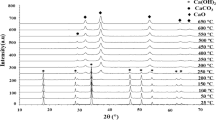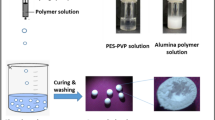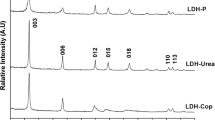Abstract
A novel composite adsorbent, hydroxyapatite/ manganese dioxide (HAp/MnO2), has been developed for the purpose of removing lead ions from aqueous solutions. The combination of HAp with MnO2 is meant to increase its adsorption capacity. Various factors that may affect the adsorption efficiency, including solution pH, coexistent substances such as humic acid and competing cations (Ca2+, Mg2+), initial solute concentration, and the duration of the reaction, have been investigated. Using this composite adsorbent, solution pH and coexistent calcium or magnesium cations were found to have no significant influence on the removal of lead ions under the experimental conditions. The adsorption equilibrium was described well by the Langmuir isotherm model, and the calculated maximum adsorption capacity was 769 mg·g−1. The sorption processes obeyed the pseudo-second-order kinetics model. The experimental results indicate that HAp/MnO2 composite may be an effective adsorbent for the removal of lead ions from aqueous solutions.
Similar content being viewed by others
References
Vilensky M Y, Berkowitz B, Warshawsky A. In situ remediation of groundwater contaminated by heavy- and transition-metal ions by selective ion-exchange methods. Environmental Science & Technology, 2002, 36(8): 1851–1855
Rivera-Utrilla J, Sánchez-Polo M, Gómez-Serrano V, Alvarez P M, Alvim-Ferraz M C M, Dias J M. Activated carbon modifications to enhance its water treatment applications. An overview. Journal of Hazardous Materials, 2011, 187(1–3): 1–23
Wang S, Yu DM. Adsorption of Cd(II), Pb(II), and Ag(I) in aqueous solution on hollow chitosan microspheres. Journal of Applied Polymer Science, 2010, 118(2): 733–739
Chen Y H, Li F A. Kinetic study on removal of copper(II) using goethite and hematite nano-photocatalysts. Journal of Colloid and Interface Science, 2010, 347(2): 277–281
Eloussaief M, Benzina M. Efficiency of natural and acid-activated clays in the removal of Pb(II) from aqueous solutions. Journal of Hazardous Materials, 2010, 178(1–3): 753–757
Hamidpour M, Kalbasi M, Afyuni M, Shariatmadari H, Holm P E, Hansen H C B. Sorption hysteresis of Cd(II) and Pb(II) on natural zeolite and bentonite. Journal of Hazardous Materials, 2010, 181(1–3): 686–691
Liao D, Zheng W, Li X, Yang Q, Yue X, Guo L, Zeng G. Removal of lead(II) from aqueous solutions using carbonate hydroxyapatite extracted from eggshell waste. Journal of Hazardous Materials, 2010, 177(1–3): 126–130
Corami A, Mignardi S, Ferrini V. Copper and zinc decontamination from single- and binary-metal solutions using hydroxyapatite. Journal of Hazardous Materials, 2007, 146(1–2): 164–170
Corami A, Acapito F D, Mignardi S, Ferrini V. Removal of Cu from aqueous solutions by synthetic hydroxyapatite: EXAFS investigation. Materials Science and Engineering B, 2008, 149(2): 209–213
Corami A, Mignardi S, Ferrini V. Cadmium removal from singleand multi-metal (Cd + Pb + Zn + Cu) solutions by sorption on hydroxyapatite. Journal of Colloid and Interface Science, 2008, 317 (2): 402–408
Smičiklas I, Dimović I, Mitrić M, Mitrić M. Removal of Co2+ from aqueous solutions by hydroxyapatite.Water Research, 2006, 40(12): 2267–2274
Jang S H, Jeong Y G, Min B G, Lyoo WS, Lee S C. Preparation and lead ion removal property of hydroxyapatite/polyacrylamide composite hydrogels. Journal of Hazardous Materials, 2008, 159 (2-3): 294–299
Jang S H, Min B G, Jeong Y G, Lyoo WS, Lee S C. Removal of lead ions in aqueous solution by hydroxyapatite/polyurethane composite foams. Journal of Hazardous Materials, 2008, 152(3): 1285–1292
Dong L J, Zhu Z L, Qiu Y L, Zhao J F. Removal of lead from aqueous solution by hydroxyapatite/magnetite composite adsorbent. Chemical Engineering Journal, 2010, 165(3): 827–834
Feng Y A, Gong J L, Zeng G M, Niu Q Y, Zhang H Y, Niu C G, Deng J H, Yan M. Adsorption of Cd (II) and Zn (II) from aqueous solutions using magnetic hydroxyapatite nanoparticles as adsorbents. Chemical Engineering Journal, 2010, 162(2): 487–494
Bogya E S, Barabás R, Csavdári A, Dejeu V, Bâldea I. Hydroxyapatite modified with silica used for sorption of copper. Chemical Paper, 2009, 63(5): 568–573
Liu G, Talley J W, Na C, Larson S L, Wolfe L G. Copper doping improves hydroxyapatite sorption for arsenate in simulated groundwaters. Environmental Science & Technology, 2010, 44(4): 1366–1372
Tripathya S S, Bersillona J L, Gopal K. Adsorption of Cd2+ on hydrous manganese dioxide from aqueous solutions. Desalination, 2006, 194(1–3): 11–21
Kanungo S B, Tripathy S S, Rajeev. Adsorption of Co, Ni, Cu, and Zn on hydrous manganese dioxide from complex electrolyte solutions resembling sea water in major ion content. Journal of Colloid and Interface Science, 2004, 269(1): 1–10
Zhu Z L, Ma H M, Zhang R H, Ge Y X, Zhao J F. Removal of cadmium using MnO2 loaded D301 resin. Journal of Environmental Sciences (China), 2007, 19(6): 652–656
Dong L, Zhu Z, Ma H, Qiu Y, Zhao J. Simultaneous adsorption of lead and cadmium on MnO2-loaded resin. Journal of Environmental Sciences (China), 2010, 22(2): 225–229
Parida K M, Kanungo S B, Sant B R. Studies on MnO2 chemical composition, microstucture and other characteristics of some synthetic MnO2 of various crystalline modification. Electrochimica Acta, 1981, 26(3): 435–443
Schwarz J A, Driscoll C T, Bhanot A K. The zero point charge of silica-alumina oxide suspensions. Journal of Colloid and Interface Science, 1984, 97(1): 55–61
Meski S, Ziani S, Khireddine H, Boudboub S, Zaidi S. Factorial design analysis for sorption of zinc on hydroxyapatite. Journal of Hazardous Materials, 2011, 186(2–3): 1007–1017
Shimabayashi S, Tamura C, Nakagaki M. Adsorption of mono- and divalent metal cations on hydroxyapatite in water. Chemical & Pharmaceutical Bulletin, 1981, 29(8): 2116–2122
Tipping E. Cation Binding by Humic Substances. England: Cambridge University Press, 2002
Wang S B, Terdkiatburana T, Tadé M O. Adsorption of Cu(II), Pb (II) and humic acid on natural zeolite tuff in single and binary systems. Separation and Purification Technology, 2008, 62(1): 64–70
Terdkiatburana T, Wang S B, Tadé M O. Competition and complexation of heavy metal ions and humic acid on zeolitic MCM-22 and activated carbon. Chemical Engineering Journal, 2008, 139(3): 437–444
Stötzel C, Müller F A, Reinert F, Niederdraenk F, Barralet J E, Gbureck U. Ion adsorption behaviour of hydroxyapatite with different crystallinities. Colloids and Surfaces B, 2009, 74(1): 91–95
Freundlich H. Colloid and Capillary Chemistry. London: Methuen, 1926, 993
Langmuir I. The constitution and fundamental properties of solid sand liquids. Part-I.Solids. Journal of the American Chemical Society, 1916, 38(11): 2221–2295
Mobasherpour I, Salahi E, Pazouki M. Removal of divalent cadmium cations by means of synthetic nano crystallite hydroxyapatite. Desalination, 2011, 266(1–3): 142–148
Wang C C, Juang L C, Lee C K, Hsu T C, Lee J F, Chao H P. Effects of exchanged surfactant cations on the pore structure and adsorption characteristics of montmorillonite. Journal of Colloid and Interface Science, 2004, 280(1): 27–35
Smičiklas I, Onjia A, Raicević S, Janaćković D, Mitrić M. Factors influencing the removal of divalent cations by hydroxyapatite. Journal of Hazardous Materials, 2008, 152(2): 876–884
Su Q, Pan B, Wan S, Zhang W, Lv L. Use of hydrous manganese dioxide as a potential sorbent for selective removal of lead, cadmium, and zinc ions from water. Journal of Colloid and Interface Science, 2010, 349(2): 607–612
Su Q, Pan B, Pan B, Zhang Q, Zhang W, Lv L, Wang X, Wu J, Zhang Q. Fabrication of polymer-supported nanosized hydrous manganese dioxide (HMO) for enhanced lead removal from waters. Science of the Total Environment, 2009, 407(21): 5471–5477
Phuengprasop T, Sittiwong J, Unob F. Removal of heavy metal ions by iron oxide coated sewage sludge. Journal of Hazardous Materials, 2011, 186(1): 502–507
Heidari A, Younesi H, Mehraban Z. Removal of Ni(II), Cd(II), and Pb(II) from a ternary aqueous solution by amino functionalized mesoporous and nano mesoporous silica. Chemical Engineering Journal, 2009, 153(1–3): 70–79
Yin H, Feng X, Qiu G, Tan W, Liu F. Characterization of Co-doped birnessites and application for removal of lead and arsenite. Journal of Hazardous Materials, 2011, 188(1–3): 341–349
Ho Y S, McKay G. Pseudo-second order model for sorption processes. Process Biochemistry, 1999, 34(5): 451–465
Author information
Authors and Affiliations
Corresponding author
Rights and permissions
About this article
Cite this article
Dong, L., Zhu, Z., Qiu, Y. et al. Removal of lead from aqueous solution by hydroxyapatite/manganese dioxide composite. Front. Environ. Sci. Eng. 10, 28–36 (2016). https://doi.org/10.1007/s11783-014-0722-5
Received:
Accepted:
Published:
Issue Date:
DOI: https://doi.org/10.1007/s11783-014-0722-5




